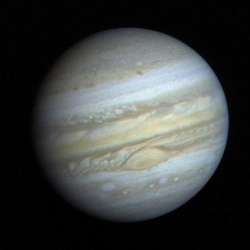Jupiter

The biggest gas giant, massing over 300 times more than Earth. It's mostly hydrogen and helium, although various other compounds provide its colorful bands and storms, and scientists believe a rocky core sits at its center. Its most prominent surface feature is called the Great Red Spot. It's a cyclone, a whirling storm 3 times as big across as the Earth. Much of the energy for Jupiter's weather appears to come from the very slow contraction of the planet.
Jupiter's orbit isn't quite circular; at perihelion, it's less than 5 A.U.[1] from the sun, but at aphelion it's nearly 5.5 A.U. away from the sun. One complete orbit takes almost 12 years. Despite its great size, Jupiter spins very rapidly on its axis, going all the way around in under 10 hours; this high rate of rotation causes the planet to bulge visibly at its equator, as though it were trying to fling some of its material off into space.
Jupiter's magnetic field is much stronger than Earth's, and its magnetosphere is larger than the sun. Unlike in Earth's magnetosphere, where most of the energy and material comes from the Solar Wind, Jupiter's magnetosphere gets most of its material from Io's volcanoes, which release gas that is stripped off the moon and ionized, and energized by Jupiter's rotation. Jupiter's magnetosphere is home to extremely strong radiation belts, a plasma torus following the orbit of Io, and radio emissions. The Auroras of Jupiter are unusual in being powered more by the planet's rotation (Through the magnetosphere plasma) than by solar wind, and the larger moons produce their own aurora like features as they pass through the magnetic field plasma.
Its gravity probably stunted Mars and kept another planet from forming where the main asteroid belt is now, but it's also well placed to deflect those nasty comets and asteroids away from us in the inner solar system. It definitely took one for the team when Comet Shoemaker-Levy 9 came calling in 1994. However, its influence on comets is a two-edged sword -- some comets which otherwise would have made a single pass through the inner solar system and headed back out into deep space never to be seen again, were instead deflected by Jupiter into short-period Solar orbits that pass through the inner solar system over and over. (Comet Halley probably had this happen to it twice.)
When the Voyager space probes passed by Jupiter in The Seventies, they discovered that the planet had rings, similar to the rings of Saturn or Uranus. These rings are invisible from the Earth, since the ring plane is tilted edge-on to the ecliptic. The ring system is also far less spectacular than the rings of Saturn; Jupiter has 4 rings, but Saturn has thousands.
The planet harbors many, many moons, some of which are listed in their own article: The Moons of Jupiter.
- ↑ A.U. stands for Astronomical Unit, the average distance between the Earth and the sun